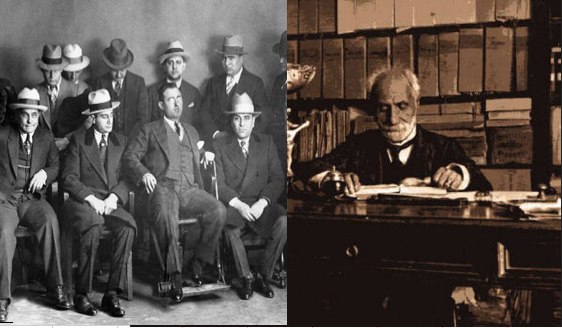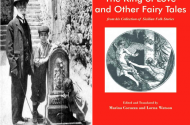“The Indomitable Giuseppe Pitrè”
In a very authoritative publication on the “Sicilian Language and Culture” Sicilia Parra - Newletter of Arba Sicula , a reviewer of Giuseppe Pitré, The King of Love and Other Fairy Tales from his Collection of Sicilian Folktales by Marina Cocuzza and Lorna Watson writes:
“Giuseppe Pitre was the most important ethnologist of Italy and he was responsible for collecting an incredible amount of material from every part of Sicily” (Spring 2012 p.15 emp. +).
More specifically, regarding “incredible amount of material”; the magnitude of Pitrè’s profoundly prodigious publications of Sicilian peasant oral tradition is difficult to grasp:
1868 Canti popolari siciliani (Sicilian Folk Songs)
1853 Raccolta dei proverbi toscani (The Collection of Tuscan Proverbs)
1869 co-founded the literary journal Nuove effemeridi siciline
1882 co-founded Archivio per lo studio delle tradizioni popolari
1885-90 Curiosita popolari tradizionali 16 volumes (Folklore Curiosiities)
1871-1914 Biblioteca delle tradizioni populari siciliane 25 volumes (The Library of Sicilian folklore)
Regarding “Every part of Sicily” – literally!
“In his preface to the first volume of Fiabe, Pitre lists 46 towns and villages as the sources of his texts…through provinces of Palermo, Agrigento, Caltanissetta and Trappani … ” (“The King of Love…”)
The Sicilia Para review goes on:
“His works constitute a veritable treasure of information about the world of Sicilians, the way they thought, the way they spoke, the proverbs they used, the feast they celebrated, and the stories they told.”
“His books are the primary sources of information for anyone interested in learning about Sicilian society of the nineteenth century.”
Given the amazingly quantitative and qualitative character of his work attested to by many generations of scholars (starting at least with Cornell University Professor of Romance Languages Frederick Crane’s book Italian Popular Tales in 1885), it seems reasonable that cultural historians of Sicily, when referring to and most especially when challenging Pitre’s representations of nineteenth century Sicilian peasant culture, are obliged to cite his text in detail, in context, and present a detailed critical analysis for the basis disagreement.
To my mind, Professors Lupo, Paoli and Schneiders have presented pejorative representations of Pitré’s writings about the use of the word ‘Mafia’ in nineteenth century Sicily (indeed Lupo implies Mafia sympathies determined Pitré’s Mafia representations); but, apart from a few out of context quotes, they have not provide a detail contextual critique that his writings deserves and critical scholarship demands.
History of Mafia - Salvatore Lupo
History of Mafia by Salvatore Lupo (Storia della mafia, translated by Anthony Shugaar) is a tour de force in historiorgaphic scholarship (921 footnotes, many annotated and a 14 page index).
While indebted to Mr. Shugaar for the invaluable service of bringing a translation to English speakers generally and Sicilian Americans particularly; nevertheless, Professor Lupo’s book is a very challenging read for Americans lacking knowledge of Sicilian political-economic history.
Many Italian historical and political nuances will escape even highly educated readers, leading to difficulty in fully understanding Professor Lupo’s meaning. For example, by way of analogy: When an American comes across expressions such as “Reagan Republican” or “New Deal Democrat”, even the non-professional reader will understand the connotative implied meanings without further explanation. They are expressions that permeate our political discourse, not only in academic works but mass media also.
Similarly, Prof. Lupo’s book is laced with expression that no doubt convey meaning to Italian readers that will be missed by an American not familiar with the history of Italian politics. For example, references to “Destra stoica (historic right wing) or politicians such as “dishonest Cosenza”, the “malevolent Crispi”, the “slimy Rudini”, and “cowardly Giolitte”; all of these expressions, likely packed with meaning for the Italian reader, will escape the non-initiated American.
Further, either Professor Lupo’s writing style or its rendition into English makes for a difficult read. Perhaps because a more highly inflected Italian language translates into the less inflected English with very long sentences and paragraphs, filled with many parenthetical phrases. In short, the book is not bedtime reading.
Nevertheless, this book is a must read for anyone interested in a scholarly presentation of Mafia history in Sicily. Even if segments are not perfectly meaningful; on the whole, the reader will come away with a much different worldview of the Mafia then before the read.
Ideally, this book would be presented to students in a comprehensive university South of Rome –History and Culture program (if that should ever happen – “I have a dream someday”) with a teacher guiding them through the obscure historical nuances. Indeed, the nuances may serve as excellent research topics for the students (e.g. “write a research paper on Destre stoica”).
Frankly, I wish I had teacher to help me with Lupo’s commentary about Pitré. Prima facie, it seems superficial in that he makes comments and characterizations about Pitré’s Mafia writings, but does not provide detailed contextualized quotations or provide historiographic critical analysis that a renown and seminal scholar like Pitre deserves; especially on a subject with the cultural implications of Mafia. Detail contextual citations and providing critical commentary is most especially required when one, as Lupo does, implies that Pitre consciously and willfully made misrepresentations because of his Mafia associations (indeed sympathies).
Pitré - Mafia 'groupie'
Professor Lupo, while referring to Pitré as “...Palermo-born, one of the leading European ethnologists of the nineteenth century”, then qualifies the compliment:
“…Sicilians can say things, or fail to say things, as it serves them best: that may be a matter of political and ideological utility (or utility of other sorts?) in Pitré’s case…” (p. 135 emp.+)
Clearly, Lupo is suggesting that Pitré’s writing must not be accepted as necessarily objective reporting about Sicily; i.e. they are “a matter of [his] political and ideological utility.” For example, regarding the definition of the word Mafia, Lupo writes:
“Pitre mischievously comments that we reach something that is almost 'impossible to define' (p.6 emp.+)
How are we to understand the meaning of the adverb “mischievously” in this context? In English, the word connotes a childish ‘naughty’ deviance. Is this really an accurate characterization of the work of a “leading European ethnologist” writing on such an important and culturally profound subject?
More importantly, Lupo goes significantly beyond accusing Pitré of being mischievous.
He is accusing Pitre of flat out deception about the meaning of the word Mafia in nineteenth century peasant Sicilian oral tradition. He writes:
“A compilation of the countless reference to the few pages that Pitré actually devoted to the Mafia would offer us an accurate and reliable map of the naïve and the corrupt from the end of the nineteenth century to the present day, all of them failing to realize (or pretending to overlook) the openly apologetic and misleading nature of those observations; all of them believing (or pretending to believe) that they were in the presence of the objective source of the culture of the Sicilians.” (p. 134 emp.+)
In the method of critical historiography, let’s break this very pregnant paragraph down into component parts that we may be perfectly clear about the allegations made against Pitré and the naiveté of those who “believed” he was an “objective source” of Sicilian culture.
Lupo:
“A compilation of the countless reference to the few pages that Pitré actually devoted to the Mafia would offer us an accurate and reliable map of the naïve and the corrupt from the end of the nineteenth century to the present day…”
Let’s be perfectly clear: Lupo is saying that Pitré’s “pages devoted to the Mafia” are associated with [“map”] “the naïve and the corrupt!
Lupo goes no:
“…all of them [i.e. “countless references” to Pitré] failing to realize (or pretending to overlook) the openly apologetic and misleading nature of those observations…
Note: here he is accusing Pitré himself of “openly misleading” and those who believe his folklore history “fail to realize” or “openly overlook” his inaccurate folklore history. We have come a long way from “mischievous”.
Lupo continues:
“…all of them [“countless references from end of the nineteenth century to the present day] believing (or pretending to believe) that they were in the presence of the objective source of the culture of the Sicilians.” … (p134 emp.+)
In short, “the few pages Pitré devoted to the Mafia” are NOT an “objective source of the culture of the Sicilians.”
If I understand this paragraph correctly, Lupo is saying that Pitré has misrepresented Sicilian peasant culture and its oral tradition about the meaning of the word ‘Mafia’ – consciously and purposely deceitful.
Lupo goes on and leaves no doubt about how he feels about Pitré’s Mafia misrepresentations:
“There are highly concrete elements that will allow us to judge the ethnologist’s [Pitré] position:
- his close collaboration in the town council and in the management of charitable works and agencies with Palizzolo [i.e. alleged Mafioso]
- his rejection of the government’s invitation to run for office in the Palizzolo-run district
- his active involvement, as an ideologue as well, in “pro-Sicila” (p. 134 paragraph format modified for emphasis)
Notice: Lupo is telling us that Pitré documentation of peasant oral mafia tradition is to be rejected NOT because the analysis of his text is found wanting or there is other documentation of the oral history that contradict the Pitré text.
Lupo does NOT present the “the few pages that Pitré actually devoted to the Mafia” and a linguist ethnographic critique of “those pages” as the basis of rejecting Pitré representation of Mafia folk traditions.
NO! We are to reject Pitré’s work because of “guilt by association” with a man charged but acquitted of conspiracy to commit murder. Pitré’s report of peasant oral tradition is also to be doubted because of his association with a Sicilian nationalist group.
More importantly, the implications of this allegation of Pitré’s willful and malicious misrepresentation of mafia folk tradition goes beyond in Lupo’s words “the few pages that Pitré actually devoted to the Mafia”. For if Pitré misrepresents Mafia folklore, then why shouldn’t all his other documentations of Sicilian oral traditions be called into question? If he misrepresented Mafia tradition how confident can we be about his documentation of Sicilian fair tale folklore traditions.
On the one hand he refers to Pitré as, one of he leading European ethnologists of the nineteenth century” and then goes on to accuse him of a scholarly conspiracy. Eventually Pitré scholars will have to deal with Lupo’s challenge to Pitré veracity based not on associations; rather on textual criticism and corroborating historic data.
‘THE’: a small word with big meaning
‘Mafia’ a noun or an adjective
In their excellent book, Reversible Destiny: Mafia, Antimafia, and the Struggle for Palermo, Jane and Peter Schneider make a vitally important point about how the simple use of the article ‘the’ affects the meaning of Mafia discourse. They write:
“To place the article ‘the’ before the word ‘mafia’, as in ‘The Genesis of the Mafia’, is to risk attributing a misplaced concreteness to an elusive phenomenon.”(p. 22)
In short, to say “the Mafia” implies an organization; the word ‘mafia’ in the pharse ‘the Mafia’ functions grammatically as a noun denoting an ‘object’, an ‘organization’. On the other hand, the word ‘mafia’ without the article ‘the’ is an adjective.
Lupo’s few actual quotations of Pitré demonstrate the use of the word in adjective form. He writes:
“ Pitré wrote, the Mafia ‘ is neither a sect nor and association…Mafia was regularly used even before 1860 in the working-class quarters of Palermo as a synonym for ‘beauty’ and ‘excellence’ and therefore a ‘mafiusu’ would be a man of courage, and ‘mafiusedda’, a beautiful and proud young woman’ ” (p. 6)
The Schneider’s provide an example of the adjective form of ‘mafia’ from their own recent experience in Palermo:
“Still today, vendors hawking their wares in crowded street markets use the word “mafia” (che mafioso!) to describe an extraordinary specimen of something—a perfectly formed, full, round cabbage, for example.” (p. 41)
Accordingly, there are two distinct uses of the word ‘mafia’: (1) an organization essentially criminal in nature, and (2) a descriptive adjective with no criminal connotation. The question at hand: when Pitré posits that the word was used in nineteenth century Sicily in adjective form, was he accurately reporting the way the word was used in nineteenth century Sicily, or was he ideologically misrepresenting how the word was used; Lupo argues ideological motivate misrepresentation.
Lupo’s Influence on Pitré Historiography
Lupo’s prestige seems to be such that more recent historians uncritically followed his lead. What may be called contemporary Pitré historiography, recent historians have accepted Lupo’s mafia sympathizer critique of Pitré. And, like Lupo, they provide no textual criticism. And, like Lupo, they open the door to doubt the veracity of other Pitré works.
Letizia Paoli in her excellent book Mafia Brotherhoods: Organized Crime, Italian Style follows Lupo's presentation of Pitré’s Mafia writings. She writes:
“For social scientists carrying out the first field studies between the 1960s and the early 1980s, the mafia was simply a form of behavior and power…no mafia organization existed.
“Though these writers by no means openly supported it, it is clear that their interpretations were strongly influenced by a movement known as sicilianismo [Sicilianism].
[note: “these writers” i.e. “social scientist” are those whom Lupo implicitly refers to with his phrase “countless references… an accurate and reliable map of the naïve and the corrupt from the end of the nineteenth century to the present day.”]
Paoli continues:
“[Sicilianismo] was a late-nineteenth-century cultural and political movement that opposed what was perceived as an indiscriminate criminalization of all Sicilians by Italian law enforcement and public opinion.
“In the eyes of the sicilianisti, the mafia was merely an attitude, the product of a particularly fierce Sicilian reaction to the foreign powers that had dominated the island for centuries. For example, the Sicilian ethnographer Giuseppe Pitrè, who contributed enormously to the promotion of this ideology… (p. 25, text emp.+, paragraph structure modified for emp.)
Like Lupo, Paoli does not think of Pitré as an objective recorder of the meaning and prevailing use of the word ‘Mafia’ in nineteenth century Sicily:
- “these writers” and “social scientist” were mislead by “the few pages that Pitré actually devoted to the Mafia” [Lupo’s words above].
- “these writers”and “social scientist”…in Lupo’s words: “failed to realize (or pretending to overlook) the openly apologetic and misleading nature of those observations; all of them believing (or pretending to believe) that they were in the presence of the objective source of the culture of the Sicilians.”
- “these writers”and “social scientist”… were strongly influenced by a movement known as sicilianismo [Sicilianism]… the ideological basis of the organization “Pro Sicilia” referred to by Lupo.
Similarly, the Schneiders explicitly follow Lupo’s and Paoli’s thinking about Pitré’s use of the word ideologically rather than empirically. They write:
Turn-of-the century figures like the physician and ethnologist Giuseppe Pitré, a leader of the Pro Sicilia defense of Notarbartolo…wrote “mafia” meant “beauty, grace, perfection and excellence of its kind …the idea of … superiority and skill in the best meaning of the word”. (p. 40)
The Schneiders, following Paoli, lump Pitré’s mafia writings under the category of “Sicilianism.” (p.40)
In Sum
All three of these very erudite historians agree that Pitré’s recordings, reportings and representations of the prevailing use of the word ‘mafia’ in nineteenth century Sicilian culture were not an accurate description of reality; rather they were a manifestations of his ideological bias and agenda.
However:
- all three quote Pitré out of context
- all three do not provide a comprehensive presentation of exactly what he wrote.
- all three do not provide critical contextual analysis of what he wrote.
Consider:
What Lupo refers to as “the few pages that Pitré actually devoted to the Mafia” are included in his book “Usi e costumi, credenze e pregiudizi del popolo siciliano, raccolti e descritti da Giuseppe Pitrè”
(Google translates as:Customs, beliefs and prejudices of the Sicilian people Collected and Described by Giuseppe Pitrè)
“Usi e costume …”, in turn consist of volumes 14-17 of the twenty-five volume“Biblioteca delle tradizioni popolari siciliane vou”
(Google translates as: Library of Sicilian folk traditions)
If we do not believe that Pitré accurately “Collected and Described” how the “Sicilian people” used the word ‘Mafia’, that he consciously and “mischievously” misrepresented the Sicilian idiom, then how can we believe all the other “Collected and Described” “Customs, beliefs and prejudices of the Sicilian people” that Pitré recorded. Where does his biases leave off and objectivity begin.
If there are doubts about volumes 14-17 of Biblioteca delle tradizioni popolari siciliane vou, how confident can we be about what is reported in the other volumes in the work.
For example, the above-mentioned book by Cocuzza and Watson The King of Love and Other Fair Tales consists of selections from Fiabe, novelle e racconti popolari siciliani i.e. volumns 4-7 of Biblioteca delle tradizioni popolari siciliane. If we have doubts about volumes 14-17 of Biblioteca, how confident can we be about volumes 4-7?
In short, Professors Lupo, Paoli and Schneiders have open a Pandora’s box of Pitré criticism by their blasé and off-handed accusations of his ideological bias about ‘mafia’, by substituting ‘guilt by associations’ and out of context quotes for detailed critical analysis of his text; they have denigrated a scholar they themselves call, and many others agree, “one of he leading European ethnologists of the nineteenth century.”








